9 Ways to Get the Most from Your Board


It’s a timeless and enduring scene, to be found all over the world, and although technology is bringing significant change to this ancient act, writing on the board remains a cornerstone of teacher-student interaction.
I was always reminded of that old definition of a lecture: ‘The movement of information from the notes of the teacher to the notes of the student, without passing through the minds of either’.
Thankfully, the wasteful practice of having students copy down page after page of information was already becoming unfashionable back when I was at school, though I do remember having to do a good deal of it. I was always reminded of that old definition of a lecture: ‘The movement of information from the notes of the teacher to the notes of the student, without passing through the minds of either’. There’s something empty about this kind of teaching, as though simply transmitting the information ensures that it had been learned.
Even the writing down of quick examples or notes can be slow and boring, for both the teacher and their students, something to be taken particularly seriously amid the prevalence of attention deficit issues. The problem is, board writing remains absolutely essential to most kinds of teaching, and is an enduring fixture of almost every in-person educational method.
So, how can we enliven this necessary tradition, and transform it from a mindless act of copying into an engaging opportunity for practice? The secret, as is so often true in successful language-learning environments, is to keep silence to a minimum.
I like to think of board-writing as a form of multi-media theater. There is something to look at – the formation of the letters and gradual construction of the example sentence – but there should also be something to hear. I talk a lot while I’m writing on the board, reading out and adding to whatever it is I’m writing. The theatrical aspect is emphasized by a couple of rather silly habits I’ve developed; I tend to over-enunciate the example, somewhat like a Shakespearian actor, rolling my ‘r’ sounds and affecting a clipped, formal pronunciation. Other times, I lapse deliberately back into my original accent – I was born in the English county of Yorkshire – to the delight and bemusement of my students.
All of this tomfoolery is intended to draw attention to the written words. It won’t work for everyone, but simply speaking what you’re writing does at least offer a second channel of communication, and eliminates the dreaded silence.
More than anything, board writing is enlivened by the notion that the teacher and students are constructing something together. I build my examples with my students, wholesale or in pieces, so that there’s a sense of achievement. Here’s an example from my classroom in Boston, working on the conditional forms with an upper-intermediate class of adults who I knew very well:
| Teacher: | OK, on to the wonders of the third conditional, people. (Writes while speaking) If I had…. Hang on, I need a verb. Hit me. |
| Students: | Go! / Have! / Know! |
| Teacher: | I like ‘know’ for this one. So, if I had known that she was… Er, guys, I need an adjective to describe her. And keep it PG-13 this time, please. |
| Students: | (Laughing) Educated / Beautiful / Rich |
| Teacher: | Nice! OK, so we’ve got, If I’d known she was rich… What’s possible, because she’s rich? |
| Student 1: | Ask her for money? |
| Student 2: | Yes, can ask for a loan. |
| Student 3: | Or ask her marry you. If she is beautiful, too. (General laughter) |
| Teacher: | All good ideas! OK, so here it is: If I had known she was rich, I would have asked her for a loan. (Goes back to underline ‘would have’). Check this out, guys… We’ve got ‘will’ in its past form here. You see that? |
| Students: | Yes / Yeah |
| Teacher: | And we need this ‘have’ every time in the third conditional. But why? Are we talking about the future, present, or past? |
| Students: | Past! |
| Teacher: | Yes! How do you know? |
| Student 4: | Because you say, ‘if I had known…’ Is a past grammar. Er, you know. Past thing. (Laughter) |
| Student 3: | Past participle? |
| Student 4: | Yeah. That one. (More laughter) |
| Teacher: | Good job, both of you! So, we need the ‘have’ because the whole thing happened in the…. |
| Students: | Past! |
| Teacher: | Awesome. Let’s do another one. You can start this. We normally begin with ‘if’. Any ideas? |
This is a way to side-step the problem. If I know I’ll need time to draw a diagram (most often during my business English classes), a ready-formed set of examples, or the questions for a quiz or homework, I’ll give the students something else to do, ask them to ignore the board, and quickly do the writing while they’re busy. They could be assigned some review or research, textbook questions, the creation of their own examples, vocabulary practice, etc.
It might sometimes be possible to have your students do the writing for you. There are risks and rewards associated with this approach. You’ll need to nominate someone who can either create the content or reliably copy it down from a sheet you hand them; they’ll likely take longer than you would, though that depends on the content. It’s also important to choose someone who can write legibly on a white board, so this is best done with students you’ve worked with for some time.
Delegating frees you to do other things – monitor the copying or another assigned task, make corrections to the previous practice exercise, etc – and it involves the students in an area long considered the teacher’s own sacred domain. I enjoy the idea that the board is for everyone, not just the teacher, another example of my view of my students as colleagues who are in no way less than, or beneath me.
Monochrome is fastest, but color enlivens the experience. Use it to highlight important points, and to draw connections through color-coding.
Many students respond positively to versions of the ‘mind-map’ idea, which utilizes diagrams, cartoons and other visual aids to make the text more vivid and memorable. Underline and emphasize important words, use stars or arrows, connect related features or words with dotted patterns, and consider stick-figure cartoons to accompany the text. I discovered how helpful this can be many years ago when teaching the passive and active voices; being able to visually represent the changing direction of action, as well as write down the sentences and highlight the critical grammar, made communicating this tricky concept far easier.
I’m a huge fan of proper preparation, and board work is no exception. Create a rough diagram of how you’re going to use your board; some teachers like to keep new vocabulary in a list on the right, with examples on the left, for instance. Consistent use of the board makes it easier for the students to follow you, and helps you keep control of the text, especially if you’re writing a lot.
For new teachers, it’s also well worth practicing on a white board, which is a rather different medium from paper, not least because you’re writing on a vertical wall. Make sure your letter formation is neat, that you don’t deviate from a straight line too much (a downward tendency is very common, at first), and that your writing can be clearly seen from distance. Ten minutes’ practice on stick-figure drawings is also a priceless addition to your visual arsenal; you’d be amazed how often they’ll come in handy.
By reducing the amount of silence, adding aural and other visual elements, and bringing your students into the act of board writing, you can make this traditional and often very slow part of the class much more interactive and enjoyable.